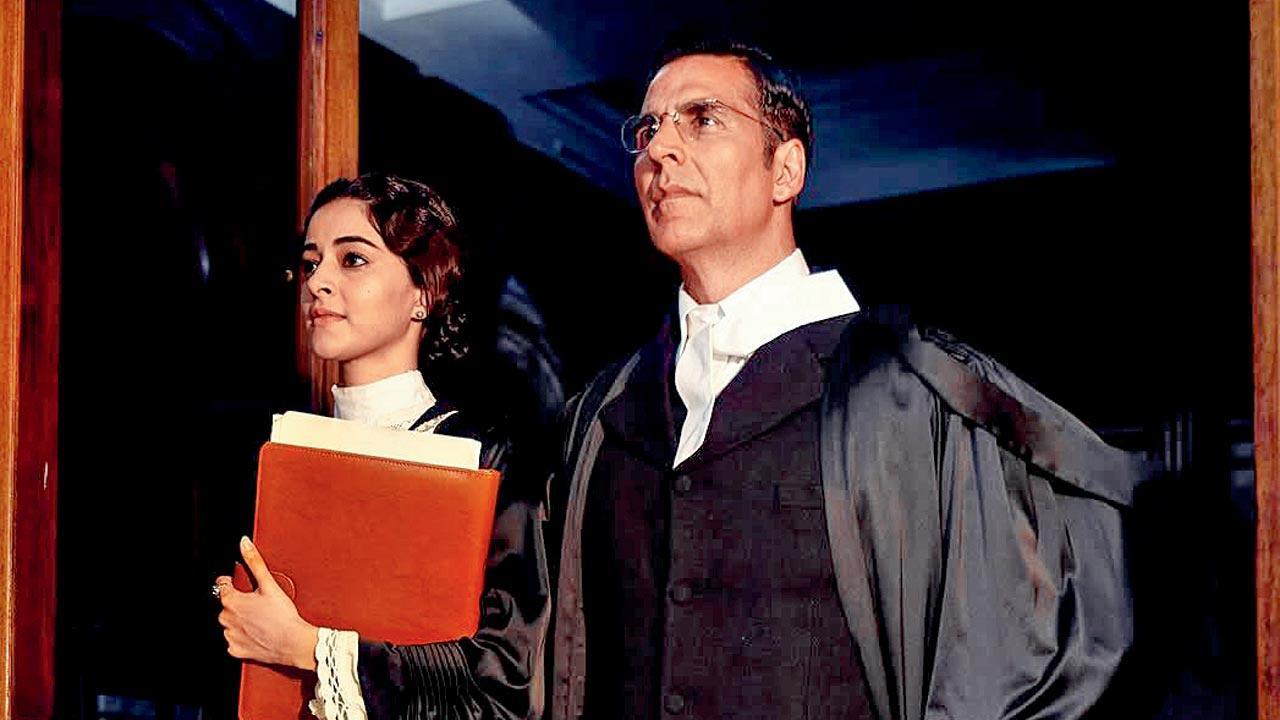
Kesari: Chapter 2
A: Historical drama
Dir: Karan Singh Tyagi
Cast: Akshay Kumar, R Madhavan, Ananya Panday
Rating: 3.5/5
The same dastardly event, i.e. the Jallianwala Bagh massacre of April 13, 1919, has been dramatised in different ways in films, from Richard Attenborough’s Gandhi (1982) to Shoojit Sircar’s Sardar Udham (2021).
While the latter recreates the genocide, in a bloodily detailed, long-drawn sort of way, Ram Madhvani’s series The Waking of a Nation (2025) deliberately avoids the explicit visuals altogether.
And that tells you all about the tone of a film/series, right away. As with Kesari Chapter 2, similarly centred on the said episode.
Wherein, upon the firing-orders of General Reginald Dyer (Simon Paisley Day), the first bullet, almost sized like a torpedo, goes off in slow motion, hitting its target, in the packed Amritsar park.
Merciless mayhem follows, while you find a li’l boy you’ve just made onscreen acquaintance with, screaming under a heap of dead bodies, that his hand struggles through, to wave out in the air.
Kesari Chapter 2 is a mainstream, emotional, historical drama. Which is inevitably the most effective way for a film/story to travel to widest audiences.
That said, there’s nothing seemingly hysterical about it. Not a moment that you’ll cringe. It’s more likely to draw critical acclaim. This is rare.
Such is the power-packed, uncluttered, uncomplicated storytelling—building scene over scene, twists over turns, and performances to top the other.
Already, there’s something ironic about this film titled as an official sequel to Anurag Singh’s Kesari (2019), which was on the 1897 Battle of Saragarhi, with unbelievably outnumbered Sikh soldiers fighting against Afghan tribesmen.
Who were the Sikhs fighting for there? Besides their own honour, the British. Who are the Sikhs fighting against, in this film?
The same British—only about two decades later, seeking freedom from the tyranny of the Empire, that’s gunned down over a thousand peaceful protestors.
Plus, that colonial state refuses to even acknowledge the incident, let alone punish its perpetrators, namely the Punjab Lt Governor Michael O’Dwyer (Mark Bennington), or their military general Dyer.
IMO, Akshay Kumar as Havaldar Ishar Singh in Kesari had delivered perhaps his finest performance till date. This is a more well-rounded role. But he’s not even a sardar in Kesari 2.
He plays a Malayali Nair. Literally, on the face of it, this might be an odd casting choice. You could simply interchange the Punjabi Tirath Singh (O’Dwyer’s legal adviser), i.e. actor Amit Sial, with Akshay, for their respective parts, and it would make more sense.
And yet, this is visibly not an issue. Akshay plays it supremely straight, hardly bothering with Malayali mannerisms/accents, or hitting unnecessary notes—he simply adds to the drama, as against getting in the way of it.
The cinema swag is important. As you would expect from this protagonist, who’s a hot-shot lawyer, knighted for his services to the Empire, where he was supposedly the only Indian on the Viceroy’s Council.
He’s meant to toe the British line on Jallianwala Bagh. He doesn’t. That’s the conflict. The resolution of which is that the world—as a result of the legal battle against the Crown—got to learn details on what arguably remains the biggest terror attack in history!
Did such a gentleman, Sir Sankaran Nair, actually exist? As it turns out, he did. We know this from husband-wife Raghu and Pushpa Palat’s book, The Case That Shook the Empire, that this picture evidently draws from.
Raghu, if I’m not mistaken, happens to be Sankaran’s great grandson. The non-fiction book, as I can see online, was sufficiently peer-reviewed.
Does it match the movie? For one, we know that the said legal battle took place in the Court of the King’s Bench in London, the Empire’s highest court. As opposed to a trial court in Amritsar/locally, here.
What else? In the sense—did the other lead in the film, R Madhavan’s drunk Anglo-Indian character, Advocate Neville McKinley, that the Brits have plucked out of ignominy, to take on Sankaran, also exist in history?
I don’t know. The picture has surely got me intrigued to pick up the book. The reverse would have served no entertainment purpose, personally.
For, while the film is on, your eyes are really glued to the turns in the case, and the sparring matches in the courtroom drama.
The plot is tight as a three-piece suit—even if you’ll excuse the characters in this film wearing them in Bombay’s Colaba, while Masaba Gupta does a sweet li’l jazz/cabaret number (nice touch, there)!
Credit for the fact that this talk-heavy picture holds your attention, through and through, must foremost go to the debutant writer-director Karan Singh Tyagi.
I don’t what it is—perhaps the film industry’s stuck between coteries and CVs—you barely come across untested filmmakers killing it on the big screen, of late. This one’s a notable exception.
I understand Jallianwala Bagh has featured already in a Hindi series and film, lately. But you can also see why it continues to inspire.
Look at the issues involved—unlawful detentions by the state; government hiding death tolls; upholders of law openly running amok against dissenters/protestors…
Besides the unimaginable tragedy, Jallianwala remains relevant forever.












